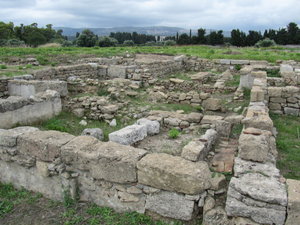Advertisement
Published: October 24th 2010

 House Megara Hyblaea
House Megara Hyblaea
A typical house layout from the Greek city of Megara Hyblaea complete with several rooms centering around a courtyard with a well. The houses would have had tiled floors.This is my first entry as an official travel blogger! Previous blogs can be viewed on my Blogspot site:
After having already visited much of the East Coast of Sicily including Messina, Taormina, Catania, and Siracusa, my friendly guide, and friend, Teo and I decided to head inland to check out the well-known mosaics of the Roman villa located near Piazza Armerina. However, our sense of adventure lead us first to the Archaic Greek ruins of Megara Hyblaea, which turned out to be rather difficult to locate but well worth the struggle. Megara Hyblaea was established in the 8th century B.C. around the same time as Naxos. The city thrived until its destruction in 483 B.C. by Gelon of Syracuse. While this site is very much in ruins and in need of restoration, it is particularly interesting because it offers a glimpse of what everyday life would have been like for ancient Greeks. Here there is a vision of husbands off luxuriating in public baths or exercising in gymnasiums with their buddies while wives tended to homes filled with screaming children, trying desperately to compete with layers of dirt. There would have been no privacy since houses were built 
 Public baths
Public baths
The tiled floors from the public baths are still visible.sharing walls and I can imagine that the smells would have been intense as well as the sounds of yells and laughter. The city would have had dramatic, arched entryways on all four sides as well as high fortress walls surrounding it. There would have been temples and columns breaking up the clusters of houses. The narrow streets would have been filled with people coming and going while others commented to each other about these comings and goings. These ruins would have been alive!
So, while it's true that Megara Hyblaea isn't as stunning as the large temples and theaters other sites have to offer, it is remarkable in its own right and well worth a visit. You'll have to drive through the countryside and probably ask a few people along the way where to go because after a certain point there aren't any signs and Google maps isn't particularly helpful. When you finally arrive at the ticket office you'll have to search for the guy who sells tickets and he'll probably look at you like, "How the heck did you find this place? I haven't seen a tourist in months." Then there is the frightening German Sheppard who

 Public baths 2
Public baths 2
These baths would have been filled with men discussing anything from politics to their mistresses.will bark at you and follow your car up to the gate where you can park because you'll be the only person in the whole site. You can pretend to be an archaeologist.
Advertisement
Tot: 0.093s; Tpl: 0.009s; cc: 9; qc: 51; dbt: 0.043s; 1; m:domysql w:travelblog (10.17.0.13); sld: 1;
; mem: 1.1mb

 House Megara Hyblaea
House Megara Hyblaea
 Public baths
Public baths
 Public baths 2
Public baths 2








